
|

|
Forum Index : Microcontroller and PC projects : RP2350 firmware
| Author | Message | ||||
| Mixtel90 Guru Joined: 05/10/2019 Location: United KingdomPosts: 6783 |
Awwww.... Just think about all those poor little electrons, having to put in all that overtime! That thing can fly.... :) What was that about the Datasheet only being a guide? (like the bus timetables round here. :( ) Mick Zilog Inside! nascom.info for Nascom & Gemini Preliminary MMBasic docs & my PCB designs |
||||
| PhenixRising Guru Joined: 07/11/2023 Location: United KingdomPosts: 857 |
Just mind blowing  |
||||
| matherp Guru Joined: 11/12/2012 Location: United KingdomPosts: 9110 |
Another better demo just loading up on youtube - have a look |
||||
| PhenixRising Guru Joined: 07/11/2023 Location: United KingdomPosts: 857 |
Would be cool to see what quality of text to expect (fonts?). |
||||
| homa Guru Joined: 05/11/2021 Location: GermanyPosts: 351 |
circle of love  |
||||
| matherp Guru Joined: 11/12/2012 Location: United KingdomPosts: 9110 |
https://youtu.be/317SQQOFp00 |
||||
| Bernie3D Newbie Joined: 02/08/2023 Location: United StatesPosts: 19 |
The 720P looks great! Nice to see 16:9. I hope this makes it into a MMBasic. |
||||
| homa Guru Joined: 05/11/2021 Location: GermanyPosts: 351 |
Is this a mmbasic mode or 'just' a demo? How did you solve the timing? Did you have another flash of inspiration? Edited 2024-09-06 17:00 by homa |
||||
| matherp Guru Joined: 11/12/2012 Location: United KingdomPosts: 9110 |
V6.00.00b6 HDMI and HDMIUSB PicoMiteHDMI.zip Edited 2024-09-07 01:06 by matherp |
||||
| Mixtel90 Guru Joined: 05/10/2019 Location: United KingdomPosts: 6783 |
Very nice. :) My monitor isn't staying locked in though. There seems to be a strange slipping in resolution in modes 2 and 3 too. I should really try it on a different display, I think. There's no guarantee that this will do it. --------------------- Edit Yes, it's this monitor as I suspected. I've tried it on a little TV and everything is rock solid. Edited 2024-09-07 01:37 by Mixtel90 Mick Zilog Inside! nascom.info for Nascom & Gemini Preliminary MMBasic docs & my PCB designs |
||||
| Sasquatch Guru Joined: 08/05/2020 Location: United StatesPosts: 362 |
Hello BackShed community, I have found that my Pimoroni devices with PSRAM won't run reliably above about 315MHz (315000KHz). I have tested multiple PGA2350B and also the Pico Plus2 devices. The Tiny2350 device with no PSRAM seems to be stable at higher Clock speeds. I can see that they all have Winbond W25Q128JVPIQ flash memory rated for 133MHz SPI clock and the APS6404L-3SQR-ZR PSRAM is also rated for 133MHz. The other thing that the "slow" devices have in common is that they use the RP2350B rather then the RP2350A used on the Tiny2350. I still don't have any of the "official" Pico 2 devices to test. This problem seems to happen whether or not the PSRAM is enabled. I am wondering if the extra "load" or possibly capacitance on the QSPI buss is limiting the maximum speed? Or perhaps the PicoMite firmware is overclocking the QSPI buss higher than 133MHz depending on the CPU Speed? And Yes, I realize that anything over 150MHz on the RP2350 devices is "use at your own risk" I am tempted to remove the PSRAM from one of the Pimoroni devices to see if it makes a difference. Before I break out the hot air rework gun, I thought I'd check in to see what ideas or experience the community have. Any thoughts on this topic? Is anyone seeing stable performance from the PGA2350 or the Pico Plus2 devices at 372000KHz or 378000KHz or similar high clock rates? Uptate: I have now tested with only USB connections for power and console so the solderless breadboard and Dupont leads don't seem to be the problem. Edited 2024-09-07 02:33 by Sasquatch -Carl |
||||
| matherp Guru Joined: 11/12/2012 Location: United KingdomPosts: 9110 |
The QSPI bus is clocked at CPU/4 so should be well within tolerance. I've tried slowing this further and my PGA2350 still won't run faster either. Looks like Pimoroni have compromised on design somewhere compared to the Pico2 - pity |
||||
| Mixtel90 Guru Joined: 05/10/2019 Location: United KingdomPosts: 6783 |
According to something I saw the M33 cores don't overclock as reliably as the M0+ cores. There may be something in that. It wouldn't explain why a RP2350A worked any better than a RP230B though. The A and B versions of the RP2350 appear to be the same until you get to the IO. The A version doesn't simply use the same pin numbered IOs as the B version because of problems in getting the bonding wires positioned correctly so the chip "translates" the IO so that it appears to be what it says. This is invisible to any running programs. Apart from that there don't seem to be any differences so any problems with speed on the PGA2350 are almost certain to be something external to the chip. Mick Zilog Inside! nascom.info for Nascom & Gemini Preliminary MMBasic docs & my PCB designs |
||||
| Sasquatch Guru Joined: 08/05/2020 Location: United StatesPosts: 362 |
I can now confirm that with the PSRAM chip removed from one of my Pimoroni Pico Plus2 modules, it is now stable at 378MHz. Testing is ongoing, I will post when I have more data to report. It is possible that the layout of the module, with the FLASH and PSRAM on the opposite side of the PCB from the RP2350B chip contributes to the issue. Perhaps with the memory Ic's placed for minimal trace lengths and without the sharp right angles of the Vias it might be more stable with both the FLASH and PSRAM??? Something to consider when the time comes to design a board for JLCPCB to manufacture. I will try this with one of my Pimoroni PGA2350 modules next. It will be interesting to see how other board designs perform when they become available. Before removal 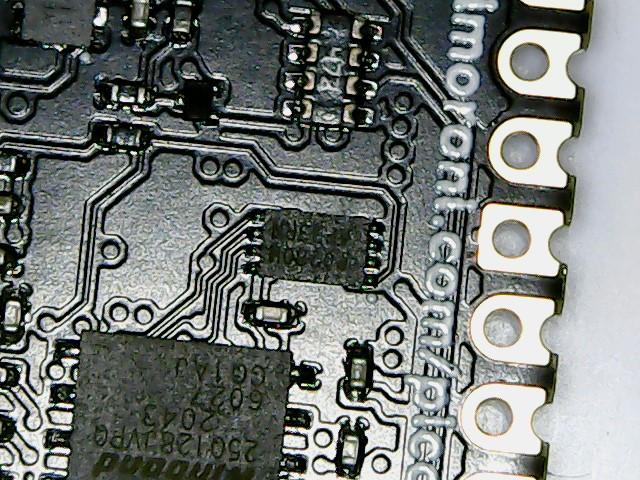 Kapton tape is your friend! 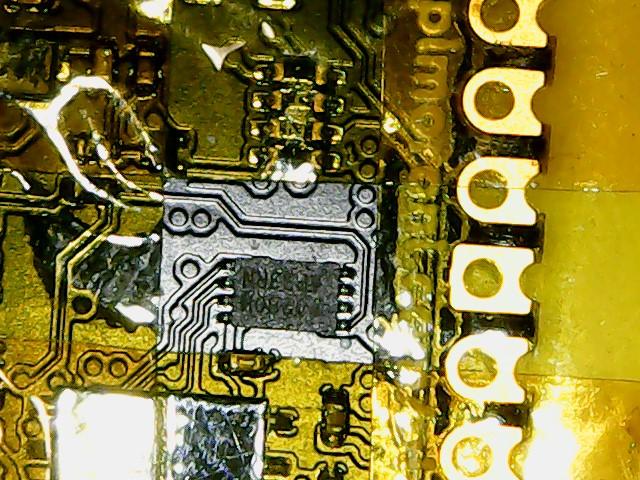 And....it's gone! 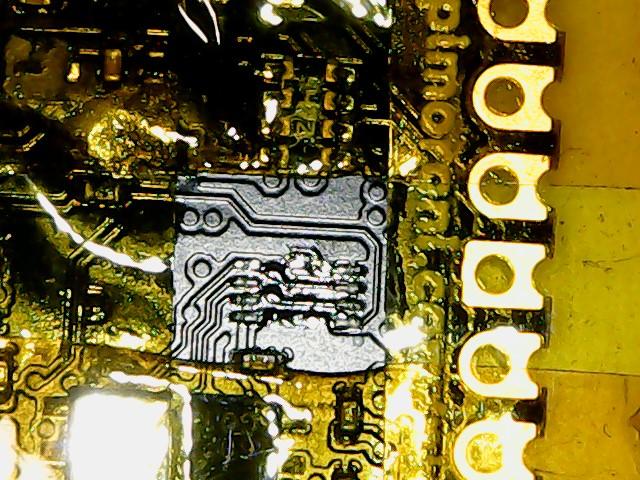 Note that the tiny PSRAM chip has a center pad with no corresponding pad on the PCB. I hope they have bonded the center pad on the RP2350B to something useful, but I'm not willing to remove one to find out. 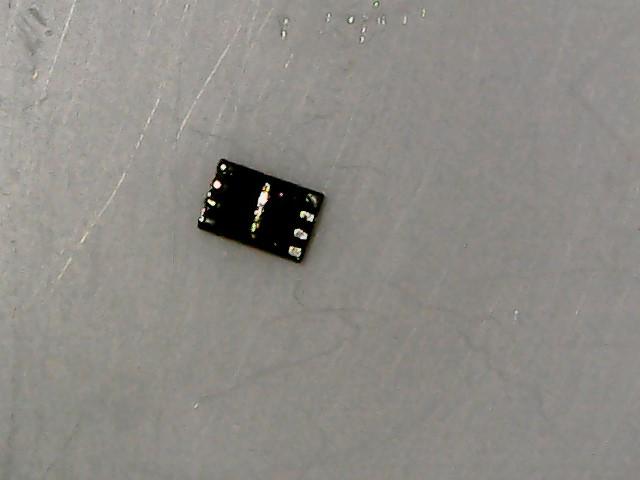 !!!Warning!! Do not attempt this without the proper equipment and experience with SMD components. There is a real chance of damaging the board beyond repair! -Carl |
||||
| Mixtel90 Guru Joined: 05/10/2019 Location: United KingdomPosts: 6783 |
Very neatly done, Carl! Nice work. Thanks for the pics - and indeed for doing it at all. :) I suspect there'll be a ground plane on an intermediate layer to screen the top and bottom sides. There normally is unless you are a cheapskate like me who sticks to 2-layer boards. :) Mick Zilog Inside! nascom.info for Nascom & Gemini Preliminary MMBasic docs & my PCB designs |
||||
| Volhout Guru Joined: 05/03/2018 Location: NetherlandsPosts: 4223 |
The PSRAM is likely a APS6404 family member. Since these are available in USON-8 package. These chips clock up to 144MHz. The centre pad is (unexpected) not connected according the datasheet. It simply has same pinout as the SOP-8 package (8 pins). One thing that can be played with, is the drive strength of the bus. But I doubt that will really solve the issue. Chance is the "split bus" does not allow for higher speeds, speeds that already far exceed the design spec of 150MHz CPU speed. Volhout Edited 2024-09-09 16:58 by Volhout PicomiteVGA PETSCII ROBOTS |
||||
| Sasquatch Guru Joined: 08/05/2020 Location: United StatesPosts: 362 |
 Sadly, My Pimoroni PGA2350 won't run at the higher clock speeds of 372 or 378 MHz even with the PSRAM removed. Sadly, My Pimoroni PGA2350 won't run at the higher clock speeds of 372 or 378 MHz even with the PSRAM removed.  Seems there may be something besides just the extra "load" on the QSPI buss going on here. Now to get that little bugger back on the PCB. LOL Seems there may be something besides just the extra "load" on the QSPI buss going on here. Now to get that little bugger back on the PCB. LOLActually, I am confident that I can replace the PSRAM when I am done playing. Given the mixed results, I'm not sure I would recommend anyone to remove the PSRAM from the Pimoroni modules to get the higher clock speeds. Both the Pico Plus2 and the PGA2350 run fine at 315MHz which works well for VGA and also allows most of the HDMI modes! Only the HDMI Widescreen modes require the higher clock speeds. The "official" Pico2 is less expensive and seems to run at the higher clock speeds just fine. Given the currently available options, it would seem that if the PSRAM or extra I/Os are needed, we will need to keep to 315MHz with the Pimoroni modules. We will see what the future holds when other module designs become available. -Carl |
||||
| WhiteWizzard Guru Joined: 05/04/2013 Location: United KingdomPosts: 2817 |
Bit late to the 'Pico party' as I have been away for a while. Now that I'm back home I have been able to order various PICO 2 goodies; and the first of many packages arrived today. Currently using a Pimoroni Pico Plus 2 and have loaded the HDMI firmware (non USB) b6. All looks good but when I went to experiment with changing the CPU speed, I get the following conflicting messages...... 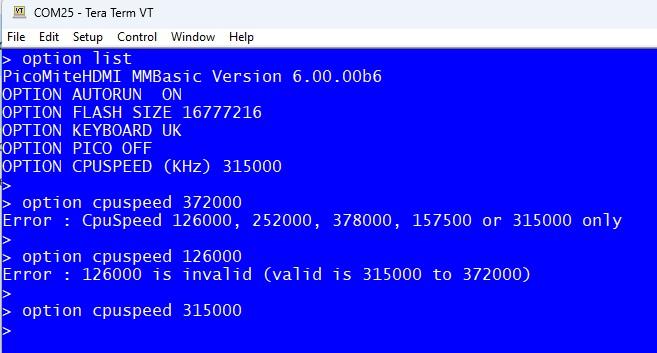 I know a lot of the firmware is still work-in-progress, and I do remember seeing mention that the HDMI requires 372000 BUT the Pimoroni module may possibly only run at 315000. The question here is: should I be able to change CPUSPEED to 372000 OR is the device being detected and hence preventing me from changing it? Also - please can anyone enlighten me as to what 'OPTION PICO OFF' is all about (I have not refered to manual as not sure what one to look at  Really looking forward to all what the PICO2 offers (great work once again Peter  ) )For everything Micromite visit micromite.org Direct Email: whitewizzard@micromite.o |
||||
| PhenixRising Guru Joined: 07/11/2023 Location: United KingdomPosts: 857 |
@WhiteWizzard No. This and the PGA version are limited to 315000 max  |
||||
| WhiteWizzard Guru Joined: 05/04/2013 Location: United KingdomPosts: 2817 |
Thanks - so does this essentially mean the only current restriction is that they can’t do 720P ? For everything Micromite visit micromite.org Direct Email: whitewizzard@micromite.o |
||||